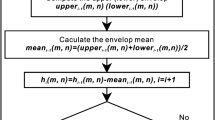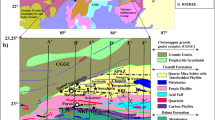Abstract
Extraction of mineralization-related anomalies for mineral exploration targeting lies in the interpretation of geological anomalies that indicate favorable ore-forming criteria and major ore-controlling criteria from potential field data, based on the metallogenic model of a study area. The integrated geophysical methods of bi-dimensional empirical mode decomposition and power spectrum analysis were applied to Bouguer gravity and original airborne magnetic data to extract (or decompose) multisource geological anomalies and estimate approximate depths of those anomalies for further interpreting multisource mineralization-related anomalies in the Tongling Cu(–Au) district of China. The results (i.e., decomposed anomaly components for interpretation) can be briefly summarized as follows: (1) high-frequency components (i.e., gravity component BIMFG1 and magnetic component BIMFM1) depict the beaded-cyclic distribution of deposit-scale geological anomalies (~ 3 to 4 km deep), indicating shallow subsurface intrusions including dykes, stocks and apophysis; (2) intermediate-frequency components (i.e., gravity component BIMFG2, BIMFG3 and magnetic component BIMFM2) depict the interaction of magmatism and major NE-trending capping structures at shallow upper-crust (~ 6 to 8 km deep), both of which comprise the tectonic–magmatic–metallogenic system in the Tongling Cu(–Au) district; (3) intermediate-low-frequency components (i.e., gravity component BIMFG4 and magnetic component BIMFM3) further verify the coupling mechanism of major capping structures and magmatism at middle upper-crust (~ 9 km deep), indicating the trend and distribution of magma chambers expanding toward depths; (4) low-frequency components (i.e., gravity component ResG and magnetic component ResM), generally seen as the background information, depict district-scale structures and the distribution of magma chamber at depths. By combining above-mentioned geophysical features and the dataset of Cu(–Au) deposits in the study area, three target zones associated with district-scale structures can be identified. Target zone (I) is distributed along the Tongguanshan anticline, and two other target zones [i.e., zone (II) and zone (III)] are distributed along the Yongcunqiao–Shujiadian anticline. Similar geological and mineralization-related anomalies, represented by above-mentioned target zones, provide exploration targeting criteria for mineral exploration in the study area.
























Similar content being viewed by others
References
Al-Rahim, A. M. (2016). Separating the gravity field of Iraq by using bidimensional empirical mode decomposition technique. Arabian Journal of Geosciences, 9(1), 43. https://doi.org/10.1007/s12517-015-2118-7.
Battista, B. M., Knapp, C., McGee, T., & Goebel, V. (2007). Application of the empirical mode decomposition and Hilbert–Huang transform to seismic reflection data. Geophysics, 72(2), H29–H37.
Biswas, A. (2017). A review on modeling, inversion and interpretation of self-potential in mineral exploration and tracing paleo-shear zones. Ore Geology Reviews, 91, 21–56.
Biswas, A., Mandal, A., Sharma, S. P., & Mohanty, W. K. (2014). Delineation of subsurface structures using self-potential, gravity, and resistivity surveys from South Purulia Shear Zone, India: Implication to uranium mineralization. Interpretation—A Journal of Subsurface Characterization, 2(2), T103–T110.
Biswas, A., & Sharma, S. P. (2015). Can very low frequency electromagnetic survey detect graphite deposits in the subsurface? Initial results from Daltanganj, Jharkhand. Journal of the Geological Society of India, 86(5), 530–534.
Biswas, A., & Sharma, S. P. (2016). Integrated geophysical studies to elicit the subsurface structures associated with Uranium mineralization around South Purulia Shear Zone, India: A review. Ore Geology Reviews, 72, 1307–1326.
Bonham-Carter, G. F. (1994). Geographic information systems for geoscientists: Modelling with GIS. Oxford [Inglaterra]: Pergamon Press.
Carranza, E. J. M. (2009). Controls on mineral deposit occurrence inferred from analysis of their spatial pattern and spatial association with geological features. Ore Geology Reviews, 35(3–4), 383–400.
Chen, J., & Jegen-Kulcsar, M. (2007). The empirical mode decomposition (EMD) method in MT data processing. In 22nd Kolloquium Elektromagnetische Tiefenforschung, October 1–5, 2007, Děčín, Czech Republic (pp. 67–76).
Chen, J., & Jegen-Kulcsar, M. (2008). The empirical mode decomposition (EMD) method and Hilbert–Huang transform (HHT) in MT data processing. In 19th IAGA WG 1.2 Workshop on Electromagnetic Induction in the Earth, October 23–29, 2008, Beijing, China (pp. 751–756).
Chen, J., & Jegen-Kulcsar, M. (2009). Empirical mode decomposition and Hilbert spectra in MT data processing. In Geophysical Research Abstracts, EGU 2009 (Vol. 11, p. 1).
Chen, Y. Q., Zhang, L. N., & Zhao, B. B. (2017). Application of Bi-dimensional empirical mode decomposition (BEMD) modeling for extracting gravity anomaly indicating the ore-controlling geological architectures and granites in the Gejiu tin-copper polymetallic ore field, southwestern China. Ore Geology Reviews, 88, 832–840.
Chen, Y., & Zhao, B. (2011). Application of BEMD in extraction of regional and local gravity anomalies associated with Au mineralization within Western Shandong Uplift Block, Eastern China. Eighth International Conference on Fuzzy Systems and Knowledge Discovery (FSKD), 2011, 1509–1517.
Chen, Y. Q., & Zhao, B. B. (2012). Extraction of gravity anomalies associated with gold mieralization: A comparison of singular value decomposition and bi-dimensional empirical mode decomposition. Future Material Research and Industry Application, Pts 1 and 2, 455–456, 1567–1577.
Deng, J., Wang, Q., Huang, D., & Gao, B. (2004a). Structural control of ore-forming fluid activities in shallow crust of tongling ore concentration area in Yanshanian period. Mineral Deposits, 23(3), 399–404.
Deng, J., Wang, Q., Huang, D., Sun, Z., & Zhang, D. (2004b). The evolutionary frame of tectonic-fluid-metallogenic system in tongling ore deposit concentrated district. Earth Science Frontiers, 11(1), 9.
Deng, J., Wang, Q., Xiao, C., Yang, L., Liu, H., Gong, Q., et al. (2011). Tectonic–magmatic–metallogenic system, Tongling ore cluster region, Anhui Province, China. International Geology Review, 53(5–6), 449–476.
Hassan, H. H. (2005). Empirical mode decomposition (EMD) of potential field data: Airborne gravity data as an example. Paper presented at the SEG Technical Program Expanded Abstracts 2005,
Hou, W. S., Yang, Z. J., Zhou, Y. Z., Zhang, L. P., & Wu, W. L. (2012). Extracting magnetic anomalies based on an improved BEMD method: A case study in the Pangxidong Area, South China. Computers & Geosciences, 48, 1–8.
Huang, N. E., Shen, Z., Long, S. R., Wu, M. L. C., Shih, H. H., Zheng, Q. N., et al. (1998). The empirical mode decomposition and the Hilbert spectrum for nonlinear and non-stationary time series analysis. Proceedings of the Royal Society A—Mathematical Physical and Engineering Sciences, 454(1971), 903–995.
Huang, J. N., Zhao, B. B., Chen, Y. Q., & Zhao, P. D. (2010). Bidimensional empirical mode decomposition (BEMD) for extraction of gravity anomalies associated with gold mineralization in the Tongshi gold field, Western Shandong Uplifted Block, Eastern China. Computers & Geosciences, 36(7), 987–995.
Jian, Z., Zhao, B., & Chen, Y. (2012). Application of bi-dimensional empirical mode decomposition (Bemd) in extraction of platinum and palladium anomalies features. Advances in Adaptive Data Analysis, 04(01n02), 1250010.
Liu, L. M., & Peng, S. L. (2004). Prediction of hidden ore bodies by synthesis of geological, geophysical and geochemical information based on dynamic model in Fenghuangshan ore field, Tongling district, China. Journal of Geochemical Exploration, 81(1–3), 81–98.
Lü, Q., Qi, G., & Yan, J. (2013). 3D geologic model of Shizishan ore field constrained by gravity and magnetic interactive modeling: A case history. Geophysics, 78(1), B25–B35.
Mandal, A., Biswas, A., Mittal, S., Mohanty, W. K., Sharma, S. P., Sengupta, D., et al. (2013). Geophysical anomalies associated with uranium mineralization from Beldih mine, South Purulia Shear Zone, India. Journal of the Geological Society of India, 82(6), 601–606.
Mandal, A., Mohanty, W. K., Sharma, S. P., Biswas, A., Sen, J., & Bhatt, A. K. (2015). Geophysical signatures of uranium mineralization and its subsurface validation at Beldih, Purulia District, West Bengal, India: A case study. Geophysical Prospecting, 63(3), 713–726.
Maus, S., & Dimri, V. (1995). Potential-field power spectrum inversion for scaling geology. Journal of Geophysical Research-Solid Earth, 100(B7), 12605–12616.
Maus, S., & Dimri, V. (1996). Depth estimation from the scaling power spectrum of potential fields? Geophysical Journal International, 124(1), 113–120.
Nunes, J. C., Bouaoune, Y., Delechelle, E., Niang, O., & Bunel, P. (2003). Image analysis by bidimensional empirical mode decomposition. Image and Vision Computing, 21(12), 1019–1026.
Nunes, J. C., Guyot, S., & Delechelle, E. (2005). Texture analysis based on local analysis of the bidimensional empirical mode decomposition. Machine Vision and Applications, 16(3), 177–188.
Pei, Y., Wu, Y.-G., & Jia, D.-C. (2012). Gravity anomaly separation based on bidimensional empirical mode decomposition. Research Journal of Applied Sciences, Engineering and Technology, 4(21), 10.
Sharma, S. P., Biswas, A., & Baranwal, V. C. (2014). Very low-frequency electromagnetic method: A shallow subsurface investigation technique for geophysical applications. In D. Sengupta (Ed.), Recent trends in modelling of environmental contaminants (pp. 119–141). New Delhi, India: Springer.
Spector, A., & Grant, F. S. (1970). Statistic models for interpreting aeromagnetic data. Geophysics, 35(2), 10.
Wang, G., Li, R., Carranza, E. J. M., Zhang, S., Yan, C., Zhu, Y., et al. (2015). 3D geological modeling for prediction of subsurface Mo targets in the Luanchuan district, China. Ore Geology Reviews, 71, 592–610.
Wang, G., Ma, Z., Li, R., Song, Y., Qu, J., Zhang, S., et al. (2017). Integration of multi-source and multi-scale datasets for 3D structural modeling for subsurface exploration targeting, Luanchuan Mo-polymetallic district, China. Journal of Applied Geophysics, 139, 269–290.
Zhang, S., Chen, C., Wang, L., Wang, Q., Wang, H., & Sun, S. (2015). The bidimensional empirical mode decomposition and its applications to denoising and separation of potential field. Progress in Geophysics, 30(6), 8.
Zhang, Z., Wang, G., Ma, Z., & Gong, X. (2017). Interactive 3D modeling by integration of geoscience datasets for exploration targeting in Luanchuan Mo polymetallic district, China. Natural Resources Research, 27(3), 315–346.
Zhao, J., Zhao, P. D., & Chen, Y. Q. (2016). Using an improved BEMD method to analyse the characteristic scale of aeromagnetic data in the Gejiu region of Yunnan, China. Computers & Geosciences, 88, 132–141.
Zhu, Z., & Liu, G. (2016). Analysis of potential field data and its application based on bidimensional empirical mode decomposition. Progress in Geophysics, 31(2), 11.
Acknowledgements
The authors are grateful to the Editor-in-Chief (Prof. John Carranza) and Prof. Lizhen Cheng (Université du Québec en Abitibi-Témiscamingue) and the anonymous reviewer for the detailed comments, and Prof. John Carranza gave his constructive comments for the abstract about this paper to the RFG 2018 Conference, Master Min Ma gave us comments on the bi-dimensional empirical mode decomposition method. The research was supported by the National Natural Science Foundation of China (Grant No. 41572318), China geology survey project (Grant No. 12120115034401), and the National Key Research Projects (Grant No. 2016YFC0600100; Grant No. 2016YFC0600500).
Author information
Authors and Affiliations
Corresponding author
Rights and permissions
About this article
Cite this article
Tao, G., Wang, G. & Zhang, Z. Extraction of Mineralization-Related Anomalies from Gravity and Magnetic Potential Fields for Mineral Exploration Targeting: Tongling Cu(–Au) District, China. Nat Resour Res 28, 461–486 (2019). https://doi.org/10.1007/s11053-018-9397-0
Received:
Accepted:
Published:
Issue Date:
DOI: https://doi.org/10.1007/s11053-018-9397-0




